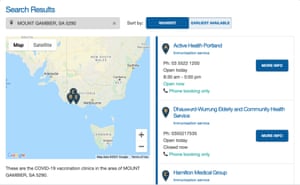“>
Those in Port Hedland, Western Australia, were told the closest clinic was a six-hour drive away in Broome. Residents of Karratha were also told to make the drive to Broome, which would take eight hours and 20 minutes.

Even then, the website says the only available clinic in Broome is the local Aboriginal Medical Service.
In Esperance, Western Australia, residents were told by the website that the closest clinic was in Boulder, a four hour drive away.
Residents of Mount Gambier, South Australia, were told the closest clinic participating in the Covid-19 rollout is across the state border in Portland, Victoria, a drive of one hour and 20 minutes.

The problem is the result of a combination of factors. In some regional areas, the commonwealth simply has not yet activated GP clinics to participate in the vaccine rollout. That is expected to occur in coming weeks, but there is no indication on the website that another 3,000 GPs are soon to be activated.
The government’s website also does not appear to take into account the existence of state-run vaccination clinics being set up in regional towns, like Katherine and Esperance, or local hospitals that may have some involvement in the vaccination program.
The absence of such critical information comes at a time of huge demand for the website, triggered by Wednesday’s government announcement.
A spokesperson for the health department said roughly 1,000 new GP clinics will be joining the program each week, which would increase coverage and availability across the country.
Further access will also be granted through 100 respiratory clinics and Aboriginal community-controlled health services, which are not currently showing up on the website.
State-run clinics have so far been prioritising phase 1a patients and workers, but will soon begin servicing the phase 1b cohort, and will then appear on the website, the spokesperson said.
Australian Medical Association president Dr Omar Khorshid told the Guardian there will be a limited supply for rural and regional practices initially, and that the first week of the 1b rollout “will look very urban”.
Khorshid was also critical that the government’s national vaccine booking system did not list all clinics participating in the rollout, and called for the government to update the website to incorporate state-run facilities to avoid regional Australians driving hours further for a vaccine than necessary.
“They tend to concentrate on their own level of government, but the states are administering vaccines at their own centres,” Khorshid said.
He said the government’s communication – which the AMA criticised in a joint statement with the Royal Australian College of General Practitioners (RACGP) earlier this week – needed to be “regional specific” to avoid current confusion.
“At the end of the day we need to get the vaccine to every Australian,” he said.
Opposition health spokesperson Mark Butler told the Guardian “the chaotic vaccine rollout needs to get back on track”.
“There needs to be clearer information for regional Australians about how, when and where they can access the vaccine,” Butler said.
Rural Doctors Association president John Hall said the website had clearly experienced “teething problems” and that the government had “pulled the trigger too early”. He said he would raise the issue identified by the Guardian with government.
“That’s certainly something to feed back. We do know there’s been a few teething problems with this rollout this week, where the portal came online and was directing people to clinics and phone lines that weren’t live yet, and couldn’t book,” he said.
But Hall said he didn’t want to be too critical of government, given the huge logistical challenge it faced. He said after Friday afternoon’s meeting with the prime minister and health minister, he was confident that there won’t be gaps in regional delivery of the vaccines.
Hall said he was also reassured that the government was addressing communication issues with GPs, through regular fact sheets, a new 1800 phone number, more regular meetings with government, and $5m in funding for GP and staff mental health.
Concerns about the regional rollout follow the troubled launch of the government’s national vaccine booking website.
On Tuesday, before the vaccine booking website launched, the RACGP and the AMA were among those warning GPs were “ill-equipped” for the vaccine rollout because clinics hadn’t received information about their doses and delivery dates.
The government launched the national vaccine booking website on Wednesday morning, and it encountered significant issues almost immediately. The website didn’t offer online booking for most clinics, instead instructing eligible vaccine recipients to call the practice.
This meant receptionists were “inundated” with callers, according to the AMA and RACGP, with most forced to reject older Australians trying to book their vaccines because they were unsure of their supplies. Many clinics have limited their initial vaccine appointments to existing patients.
Industry insiders later accused the government of launching the website before medical booking platform providers were told to prepare their services, despite health minister Greg Hunt insisting he had always planned for the website to go live on Wednesday.
The government has called for patience in the initial phases of the 1b rollout, especially before locally produced AstraZeneca vaccines are distributed and significantly increase supplies. The Guardian understands the first locally produced vaccines will leave CSL’s Melbourne factory for delivery by early next week.
The Guardian contacted Greg Hunt for clarification on the regional rollout.

This content first appear on the guardian
